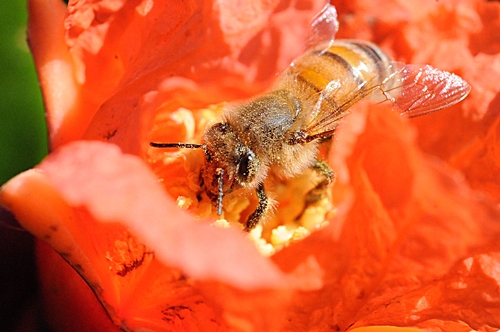Jul 29, 2010
Are you ready to celebrate something really important in your life?
Without this "something," your table fare would be sparse.
What?
Honey bees.
And now, there's an official day to celebrate them.
The second annual National Honey Bee Awareness Day is set Saturday, Aug. 21.
The good folks at Pennsylvania Apiculture last year launched the first National Honey Bee Awareness Day to "bring together beekeepers, bee associations and clubs, as well as other interested groups and individuals to connect with communities and advance beekeeping."
They created a website filled with educational information, fun facts about bees, and how to help them survive.
This year the focus is on honey, local honey. The theme: "Local Honey-- Good for Bees, You, and the Environment!”
Of course, bees are more valuable for their pollination services than the honey they produce. Honey bees pollinate about one-third of the American diet. In fact, it's said that "between 50 to 80 percent of the world’s food supply is directly or indirectly affected by honey bee pollination," according to the National Honey Bee Awareness Day website. "Whether it’s pollination of apples, or pollination of the seeds to produce grain for livestock, the food chain is linked to honey bees. The world's production of food is dependent on pollination, provided by the honey bees."
So it was with great concern that we read last week about the killing of two bee colonies at an urban farm in San Francisco. Seems that someone invaded the Hayes Valley Farm--where the non-profit San Francisco Bee-Cause keeps its bees--and deliberately sprayed pesticides inside the openings of three hives. Two colonies collapsed and died--and not because of colony collapse disorder (CCD). The third hive sustained major losses.
Pesticides. Pesticides killed them.
Each hive held between 60,000 and 100,000 bees, so around 200,000 bees died.
Ironically, the bee hives were there not only for pollination, but as educational tools. And the honey was to be sold to benefit more educational activities.
Some theorize that the culprit hates or fears bees, and sought to eliminate them.
Perhaps the vandal would want to exist on foods NOT requiring bee pollination, such as wind-pollinated or self-pollinated crops like barley, corn, oats, rice, rye, sorghums and wheat.
Without this "something," your table fare would be sparse.
What?
Honey bees.
And now, there's an official day to celebrate them.
The second annual National Honey Bee Awareness Day is set Saturday, Aug. 21.
The good folks at Pennsylvania Apiculture last year launched the first National Honey Bee Awareness Day to "bring together beekeepers, bee associations and clubs, as well as other interested groups and individuals to connect with communities and advance beekeeping."
They created a website filled with educational information, fun facts about bees, and how to help them survive.
This year the focus is on honey, local honey. The theme: "Local Honey-- Good for Bees, You, and the Environment!”
Of course, bees are more valuable for their pollination services than the honey they produce. Honey bees pollinate about one-third of the American diet. In fact, it's said that "between 50 to 80 percent of the world’s food supply is directly or indirectly affected by honey bee pollination," according to the National Honey Bee Awareness Day website. "Whether it’s pollination of apples, or pollination of the seeds to produce grain for livestock, the food chain is linked to honey bees. The world's production of food is dependent on pollination, provided by the honey bees."
So it was with great concern that we read last week about the killing of two bee colonies at an urban farm in San Francisco. Seems that someone invaded the Hayes Valley Farm--where the non-profit San Francisco Bee-Cause keeps its bees--and deliberately sprayed pesticides inside the openings of three hives. Two colonies collapsed and died--and not because of colony collapse disorder (CCD). The third hive sustained major losses.
Pesticides. Pesticides killed them.
Each hive held between 60,000 and 100,000 bees, so around 200,000 bees died.
Ironically, the bee hives were there not only for pollination, but as educational tools. And the honey was to be sold to benefit more educational activities.
Some theorize that the culprit hates or fears bees, and sought to eliminate them.
Perhaps the vandal would want to exist on foods NOT requiring bee pollination, such as wind-pollinated or self-pollinated crops like barley, corn, oats, rice, rye, sorghums and wheat.
Attached Images:

Vegetable

Fruit

Nut